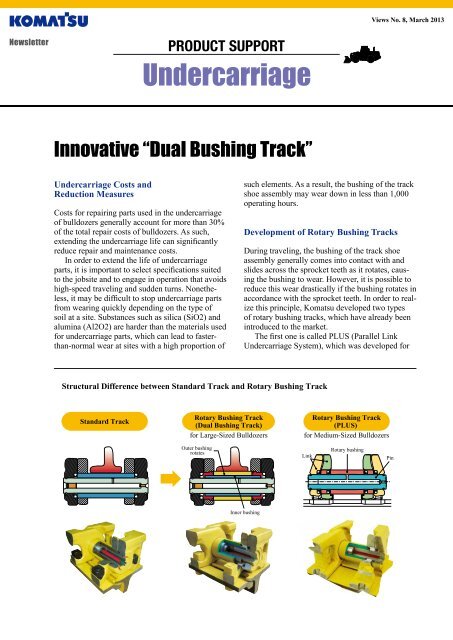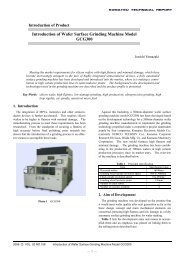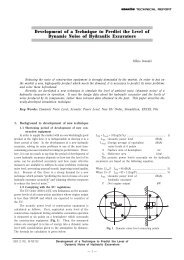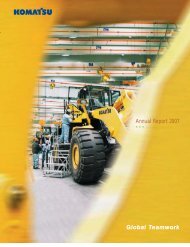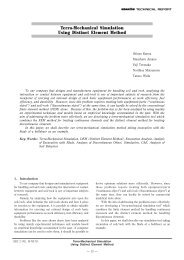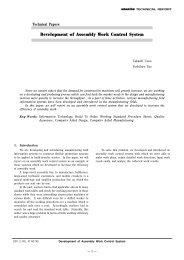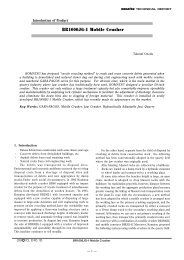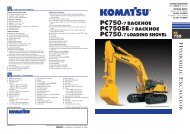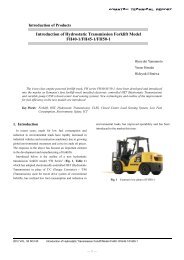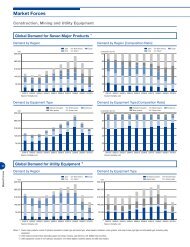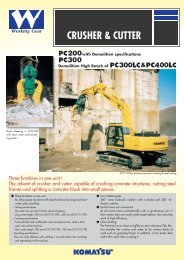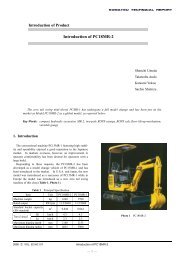Dual Bushing Track - Komatsu
Dual Bushing Track - Komatsu
Dual Bushing Track - Komatsu
Create successful ePaper yourself
Turn your PDF publications into a flip-book with our unique Google optimized e-Paper software.
Views No. 8, March 2013<br />
PRODUCT SUPPORT<br />
Undercarriage<br />
Innovative “<strong>Dual</strong> <strong>Bushing</strong> <strong>Track</strong>”<br />
Undercarriage Costs and<br />
Reduction Measures<br />
Costs for repairing parts used in the undercarriage<br />
of bulldozers generally account for more than 30%<br />
of the total repair costs of bulldozers. As such,<br />
extending the undercarriage life can significantly<br />
reduce repair and maintenance costs.<br />
In order to extend the life of undercarriage<br />
parts, it is important to select specifications suited<br />
to the jobsite and to engage in operation that avoids<br />
high-speed traveling and sudden turns. Nonetheless,<br />
it may be difficult to stop undercarriage parts<br />
from wearing quickly depending on the type of<br />
soil at a site. Substances such as silica (SiO2) and<br />
alumina (Al2O2) are harder than the materials used<br />
for undercarriage parts, which can lead to fasterthan-normal<br />
wear at sites with a high proportion of<br />
such elements. As a result, the bushing of the track<br />
shoe assembly may wear down in less than 1,000<br />
operating hours.<br />
Development of Rotary <strong>Bushing</strong> <strong>Track</strong>s<br />
During traveling, the bushing of the track shoe<br />
assembly generally comes into contact with and<br />
slides across the sprocket teeth as it rotates, causing<br />
the bushing to wear. However, it is possible to<br />
reduce this wear drastically if the bushing rotates in<br />
accordance with the sprocket teeth. In order to realize<br />
this principle, <strong>Komatsu</strong> developed two types<br />
of rotary bushing tracks, which have already been<br />
introduced to the market.<br />
The first one is called PLUS (Parallel Link<br />
Undercarriage System), which was developed for<br />
Structural Difference between Standard <strong>Track</strong> and Rotary <strong>Bushing</strong> <strong>Track</strong><br />
Standard <strong>Track</strong><br />
Rotary <strong>Bushing</strong> <strong>Track</strong><br />
(<strong>Dual</strong> <strong>Bushing</strong> <strong>Track</strong>)<br />
for Large-Sized Bulldozers<br />
Rotary <strong>Bushing</strong> <strong>Track</strong><br />
(PLUS)<br />
for Medium-Sized Bulldozers<br />
Outer bushing<br />
rotates<br />
Link<br />
Rotary bushing<br />
Pin<br />
Inner bushing
medium-sized bulldozers and is installed in the<br />
D51, D61 and D65 models (introduced in a 2008<br />
issue of Views). The second is called the “<strong>Dual</strong><br />
<strong>Bushing</strong> <strong>Track</strong>,” which was developed for largesized<br />
bulldozers. Details regarding the <strong>Dual</strong> <strong>Bushing</strong><br />
<strong>Track</strong> are featured herein.<br />
Unlike PLUS (in which the bushing rotates<br />
around the pin), the <strong>Dual</strong> <strong>Bushing</strong> <strong>Track</strong> employs a<br />
double bushing structure in which the outer bushing<br />
rotates freely around the inner bushing. For that<br />
reason, it is highly effective at jobsites containing<br />
sand and soil that cause bushing to wear quickly,<br />
culminating in an extended life not only for the<br />
bushing but also for the sprocket teeth.<br />
Comparison of Useful Life Based on Actual Results<br />
(Standard <strong>Track</strong>/<strong>Dual</strong> <strong>Bushing</strong> <strong>Track</strong>)<br />
Ahead of the development of the <strong>Dual</strong> <strong>Bushing</strong><br />
<strong>Track</strong>, customers expressed a strong desire for longer<br />
life of the undercarriage on the D275 and swift<br />
introduction. Accordingly, <strong>Komatsu</strong> sought to keep<br />
required changes to existing parts to a bare minimum<br />
and used the same standard parts for the links<br />
that form the mount for the track shoe assembly.<br />
The only new structural component in the design<br />
was the bushing. When switching from an existing<br />
track shoe assembly, it is also possible to replace<br />
the teeth as a set, making it easy to fit on bulldozers<br />
already in operation. The <strong>Dual</strong> <strong>Bushing</strong> <strong>Track</strong><br />
has been commercialized for the D275, D375 and<br />
D475 so far.<br />
* The <strong>Dual</strong> <strong>Bushing</strong> <strong>Track</strong> is not durable in withstanding impact<br />
shock. Therefore, it is advisable to avoid using at jobsites with rocky<br />
or rough ground.<br />
Link assembly<br />
(track life)<br />
Link height<br />
<strong>Bushing</strong> outer<br />
diameter<br />
Sprocket teeth<br />
Hours<br />
1,000 2,000 3,000 4,000<br />
700 hours<br />
1,300 hours<br />
1,300 hours<br />
Turn pins and bushings at 700 hours<br />
3,500 hours<br />
3,500 hours<br />
<strong>Dual</strong> <strong>Bushing</strong> <strong>Track</strong><br />
Standard <strong>Track</strong><br />
Example and Effects of Applying <strong>Dual</strong><br />
<strong>Bushing</strong> <strong>Track</strong><br />
The diagrams show a customer case in which the<br />
undercarriage life was significantly extended by<br />
using the <strong>Dual</strong> <strong>Bushing</strong> <strong>Track</strong>. The D275 bulldozer<br />
was in operation at a phosphorous mine. Although<br />
the bushing and teeth had worn down after 700<br />
hours of operation on a standard track shoe assembly,<br />
fitting a <strong>Dual</strong> <strong>Bushing</strong> <strong>Track</strong> enabled 3,500<br />
hours of operation. This equated to a 46% reduction<br />
in operating costs for the customer.<br />
Operating hours<br />
Operating hours: 700 hours<br />
Standard<br />
<strong>Track</strong><br />
700 hours<br />
Over wear limit<br />
<strong>Bushing</strong><br />
Segment teeth<br />
Operating hours<br />
900 hours 3,500 hours<br />
<strong>Dual</strong> <strong>Bushing</strong><br />
<strong>Track</strong><br />
Operating hours: 900 hours<br />
Operating hours: 3,500 hours<br />
<strong>Bushing</strong><br />
Small wear<br />
Segment teeth<br />
Below wear limit<br />
<strong>Bushing</strong><br />
Segment teeth<br />
2-3-6, Akasaka, Minato-ku, Tokyo 107-8414, Japan<br />
http://www.komatsu.com<br />
We welcome any comments from readers via email:<br />
views@komatsu.co.jp<br />
• Product photos in this newsletter may show optional equipment.<br />
• Product specifications are subject to change without notice.<br />
• Available models may vary by region or country.<br />
• Models shown in this newsletter may be positioned for photographic purposes, with the bucket up.<br />
For safety reasons, please leave the equipment in a secure position.<br />
• All rights reserved. No part of this newsletter may be reproduced without the prior written permission of <strong>Komatsu</strong> Ltd.<br />
• The comments expressed in this newsletter are those of the contributors, and are not necessarily endorsed by <strong>Komatsu</strong> Ltd.


